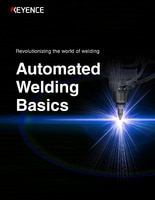Upset welding
This page introduces the basic principles of upset welding, which gets its name from the “upsetting” effect on the welded part.
This method holds base materials with their joint ends together, applies pressure and then passes a current through the abutting surfaces. The materials are joined with the heat generated by electrical resistance (Joule heat).
Unlike resistant spot welding that holds two overlaid base materials with electrodes, upset welding welds the joint ends of the materials. Upset is formed around the weld.
This method is used for welding metal wires or rods with small cross-sectional areas.




